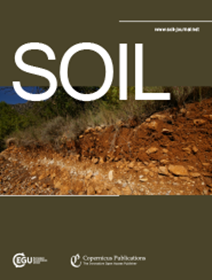Depth dependence of soil organic carbon additional storage capacity in different soil types by the 2050 target for carbon neutrality
IF 4.3
2区 农林科学
Q1 SOIL SCIENCE
引用次数: 0
Abstract
Abstract. Land planning projects aiming to maximize soil organic carbon (SOC) stocks are increasing in number and scope, often in line with the objective to reach carbon neutrality by 2050. In response, a rising number of studies assesses where additional SOC could be stored over regional to global spatial scales. In order to provide realistic values transferrable beyond the scientific community, studies providing targets of SOC accrual should consider the timescales needed to reach them, taking into consideration the effects of C inputs, soil type, and depth on soil C dynamics. This research was conducted in a 320 km2 territory in north-eastern France, where eight contrasted soil types have been identified, characterized, and mapped thanks to a high density of fully described soil profiles. Continuous profiles of SOC stocks were interpolated for each soil type and land use (cropland, grassland, or forest). We defined potential targets for SOC accrual using percentile boundary lines and used a linear model of depth-dependent C dynamics to explore the C inputs necessary to reach those targets within 25 years. We also used values from the literature to model C input scenarios and provided maps of SOC stocks, maximum SOC accrual, and realistic SOC accrual over 25 years. SOC stocks and maximum SOC accrual are highly heterogenous over the region of study. Median SOC stocks range from 78–333 tC ha−1. Maximum SOC accrual varies from 19 tC ha−1 in forested Leptosols to 197 tC ha−1 in grassland Gleysols. The simulated realistic SOC accrual over 25 years in the whole region of study was one-fifth of the the maximum SOC accrual. Further consideration of depth-dependent SOC dynamics in different soil types is therefore needed to provide targets of SOC storage over timescales relevant to public policies aiming to approach carbon neutrality by 2050.2050年碳中和目标对不同土壤类型土壤有机碳附加储量的深度依赖性
摘要。旨在最大化土壤有机碳(SOC)储量的土地规划项目在数量和范围上都在增加,通常符合到2050年实现碳中和的目标。作为回应,越来越多的研究评估了在区域到全球的空间尺度上,哪些地方可以储存额外的有机碳。为了在科学界之外提供可转移的现实值,提供有机碳积累目标的研究应考虑达到这些目标所需的时间尺度,并考虑C输入、土壤类型和深度对土壤C动态的影响。这项研究是在法国东北部320平方公里的领土上进行的,在那里,由于高密度的完整描述的土壤剖面,已经确定了八种对比土壤类型,并对其进行了表征和绘制。对不同土壤类型和土地利用方式(农田、草地或森林)的有机碳储量进行了插值。我们使用百分位边界线定义了有机碳积累的潜在目标,并使用深度相关的碳动态线性模型来探索在25年内达到这些目标所需的碳输入。我们还使用文献中的值来模拟C输入情景,并提供了25年来SOC储量、最大SOC积累和实际SOC积累的地图。有机碳储量和最大有机碳累积量在研究区域内具有高度异质性。SOC库存中值范围为78-333 tC ha - 1。土壤有机碳累积最大值从森林细坡土壤的19 tC ha - 1到草地浅坡土壤的197 tC ha - 1。整个研究区25年来模拟的真实碳积累量为最大碳积累量的五分之一。因此,需要进一步考虑不同土壤类型中依赖深度的有机碳动态,以提供与旨在到2050年实现碳中和的公共政策相关的时间尺度上的有机碳储存目标。
本文章由计算机程序翻译,如有差异,请以英文原文为准。
求助全文
约1分钟内获得全文
求助全文
来源期刊

Soil
Agricultural and Biological Sciences-Soil Science
CiteScore
10.80
自引率
2.90%
发文量
44
审稿时长
30 weeks
期刊介绍:
SOIL is an international scientific journal dedicated to the publication and discussion of high-quality research in the field of soil system sciences.
SOIL is at the interface between the atmosphere, lithosphere, hydrosphere, and biosphere. SOIL publishes scientific research that contributes to understanding the soil system and its interaction with humans and the entire Earth system. The scope of the journal includes all topics that fall within the study of soil science as a discipline, with an emphasis on studies that integrate soil science with other sciences (hydrology, agronomy, socio-economics, health sciences, atmospheric sciences, etc.).
 求助内容:
求助内容: 应助结果提醒方式:
应助结果提醒方式:


